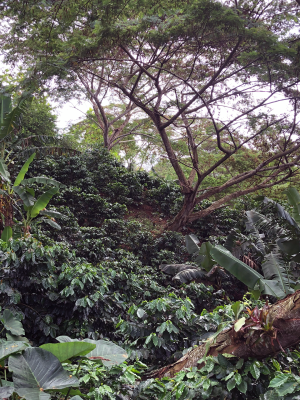Shade-Grown Coffee Yields a Better Product and Top-Notch Wildlife Habitat

By growing coffee in the shade under a forest canopy instead of directly in the sun, Puerto Rico farmers help a variety of wildlife and improve the quality of their crop.

The coffee shrub, which originated in Ethiopia, grows naturally in the shade. But over the years, many Puerto Rican growers cleared shade trees to boost yields. Now, in an effort to grow higher-quality coffee, conserve natural resources and help wildlife, the island’s growers are bringing back shade trees.
Shade-grown coffee is especially important to wildlife in places where deforestation is common. Shade-grown coffee plantations provide refuge, shelter and nesting sites for the Puerto Rican parrot, sharp-shinned hawk, Puerto Rico nightjar, elfin woods warbler, and many other birds and wildlife species. Researchers have suggested that both birds and orchids have survived periods of deforestation in Puerto Rico because of the presence of shade coffee plantations.
Additionally, forest-based pollinators have been shown to increase coffee yields by 20 percent within one kilometer of the forest. This pollination can also improve coffee quality by reducing the frequency of small, misshapen seeds called “pea berries.”
Puerto Rico’s Coffee Industry
Coffee plants came to Puerto Rico in 1736, and later in the 19th century became the island’s principal crop. A war and hurricanes destroyed the island’s coffee industry. Today, Puerto Rico's coffee crop is just a fraction of what it was during its heyday, and little is exported. But the U.S. territory is still America’s leading coffee producer, ahead of Hawaii, the only other part of the United States where coffee is grown in any sizable amount.
Most coffee plantations are small family farms located on humid mountains in central and western Puerto Rico. This area has steep, mountainous terrain and a cool climate in humid and wet subtropical forests.
Creating the Perfect Conditions
Coffee shrubs need specific environmental and ecological conditions for the best vigor, growth and berry production. In Puerto Rico, farmers need to recreate favorable coffee growing conditions for both coffee production and the environment.
One important way to maintain ideal coffee-growing temperatures is to manage shade on the plantation. Shade trees help to reduce potential evapotranspiration by modifying solar radiation. The amount of sunlight in shade coffee plantations is managed by pruning shade trees.
Assistance for Coffee Growers

NRCS offers technical and financial assistance to Puerto Rico’s coffee growers to help them convert to shade-grown plantations that provide not only optimal growing conditions, but the primary objective of creating valuable wildlife habitat.
To accelerate this conversion, NRCS launched the Shade-Grown Coffee Initiative about 10 years ago. With the help of conservation partners like the U.S. Fish and Wildlife Service and EnviroSurvey, Inc., NRCS has worked with growers to plant over 83,000 shade trees. Through this initiative, growers have created a habitat corridor, connecting the Maricao State Forest with other forest habitat.
NRCS helps growers plant native trees, such as river coco, dog almond, guamá, Spanish elm and cojoba cojoba, on their plantations. These reforestation efforts are mostly done by hand planting.

The Benefits Abound
Shade-grown coffee conserves soil and water, improves water quality and provides wildlife habitat. It can also provide socioeconomic benefits, such as the production of other sustainable forest products, and the reintroduction of traditional jobs and cultural activities for local coffee pickers.
This effort in Puerto Rico is one of many across the country through which farmers, ranchers and forest landowners are voluntarily conserving habitat for wildlife. From the sagebrush sea in the West to forests in the East, wildlife are thriving on privately owned lands. Read more success stories in our new magazine, Working Lands for Wildlife: A Partnership for Conservation Landscapes, Communities & Wildlife.
Additional Information
Shade Coffee for the Caribbean
NRCS Caribbean is helping Puerto Rico’s farmers to convert their sun-grown coffee plantations to shade-grown coffee to protect, enhance and conserve soil, water and wildlife habitat. Promoting shade-grown coffee is a partnership between NRCS, the U.S. Fish and Wildlife Service (USFWS) and local NGOs
Learn MoreEstablish biological corridors and restore ecosystem functionality in the Puerto Rico coffee region post-María
The first Caribbean Joint Chiefs’ project was a reforestation project begun in Dec. 2017 in the wake of the devastation wreaked by hurricanes Irma & María. The project established biological corridors and restored ecosystem functionality post-hurricane in the central mountains of western Puerto Rico
Learn More
